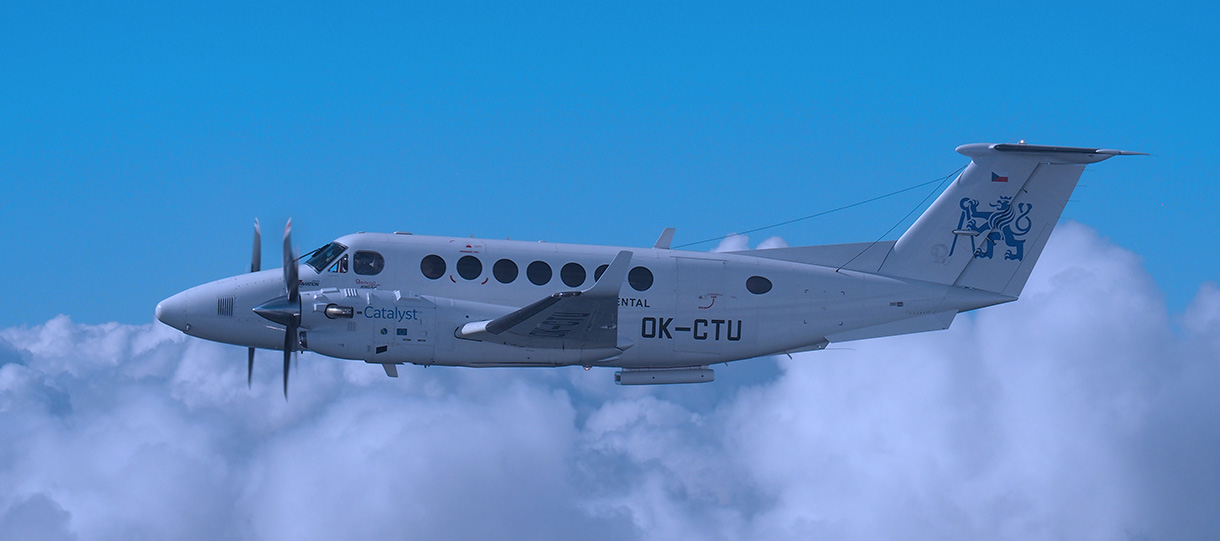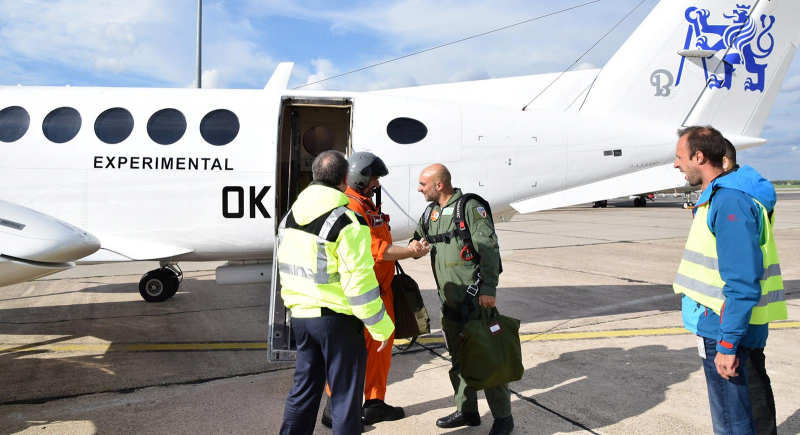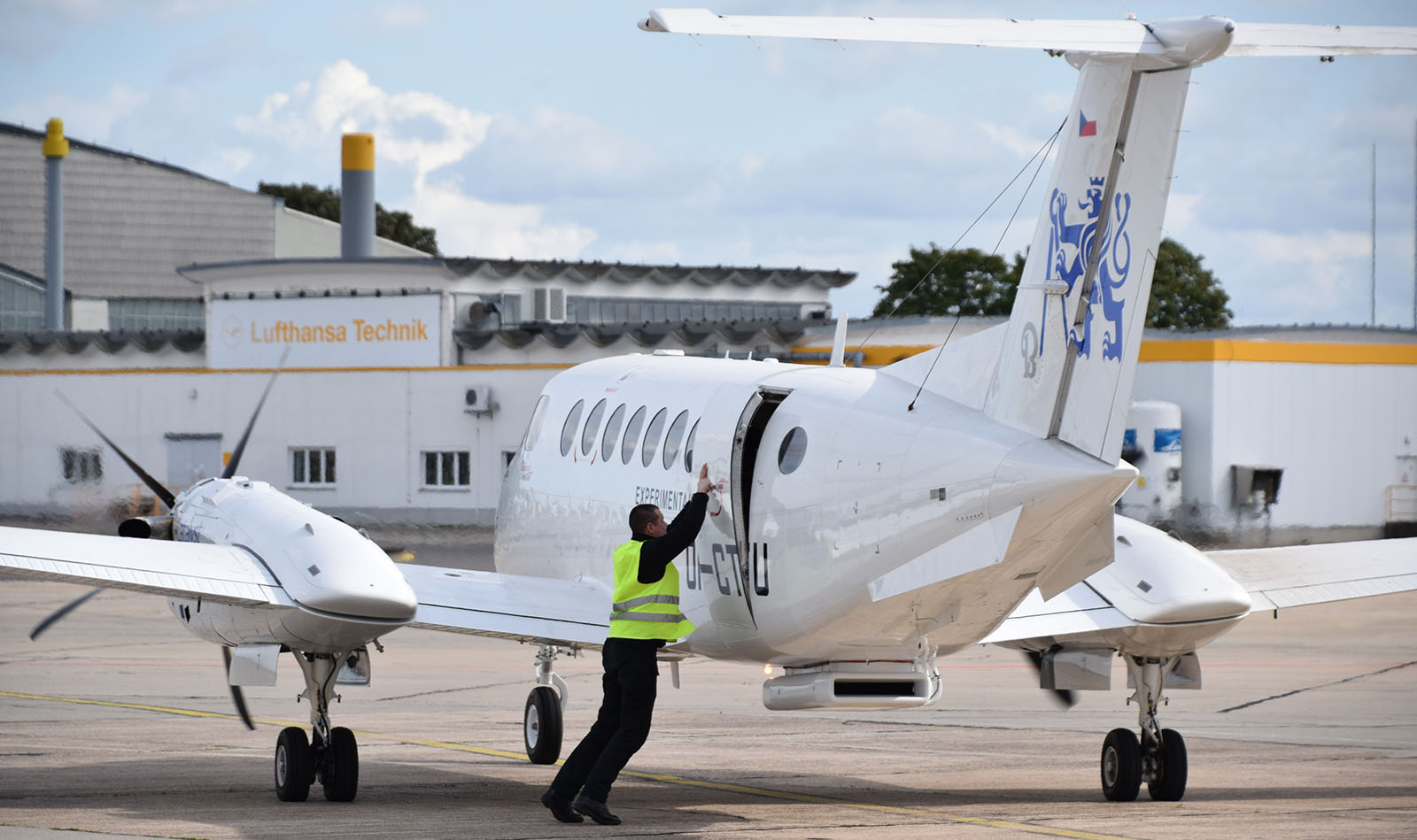Aviation
Making History
The new Catalyst turboprop first flight seen from the eyes of the European team leading the flight testing and part of the design, that started out 6 years ago from a clean sheet.
Oct 2021
Early morning of Thursday, 30 September, the sky above Berlin airport is streaked with oblong clouds, silhouetted against a deep pink horizon that tenuously fade to a clear cerulean hue. The weather presents a fully autumnal temperature, and a cool wind blows at over 20 knots.
The emotional atmosphere, instead, at the Berlin hangar - home to the experimental King Air 350 aircraft on the left wing of which the new Catalyst engine was installed last December – seems rather warm. A mix of tension, excitement and anxiety is clearly visible and recalls those penalty-kickout sensations that, just last summer, many European fans felt in the final stages of the continental tournament.
Before noon, pilots and test engineers are outside the hangar’s for the technical tune-up that precedes take-off: Federico Dellavalle and Pavel Rensa, the first part of Avio Aero and the second from the CVUT Czech Technical University partner of GE Aviation Turboprop, are extremely focused while walking around the Flying Test Bed (FTB, technical name for the test plane): they are final checking the engines, under the aircraft belly and the digital settings onboard.
Federico is the Catalyst Flight Test Director for Avio Aero, the first who arrived at the Berlin hangar in November 2019, shortly after in Prague - at the closing of the call for tenders - the CVUT University decreed the Beechcraft King Air 350 as the chosen aircraft to take on the flight tests of the first engine ever designed from scratch and built in Europe within the GE's global family.
After joining the Avio Aero Engineering team in 2012 at the Rivalta Headquarters - where, three years later, dozens of engineers began the design and development of the Catalyst engine system - Federico Dellavalle first specialized in transmission technologies by working on advanced R&D programs like SAGE by Clean Sky and, in 2016, he seized what he still calls "the opportunity of a lifetime".
"I have always dealt with NTI/NPI (new technology/product introduction, ed.), initially on a module and component level but, as the teams that would have worked on a radically new engine built from scratch with revolutionary technologies were being set up, I spent every last ounce of my energy to be part of Catalyst from day one”. Recalls Dellavalle, quoting the typical, common hunch that anticipates many individual successes: "during the interviews to join the program, I was afraid they wouldn't consider me but, instead, it was a wonderful surprise!"
Having won the bet with himself, Dellavalle immediately set to work, connecting the Rivalta and Bari teams - who developed digital controls, or FADEC, for engines and propellers - with those in Prague who were beginning to work on the integration of FTB and engine. “With the Czech colleagues, we started from the performance (my specialty) and from the functioning we wanted the engine to have once installed on the test aircraft, up to the mechanical and digital integration issues that allowed me to learn a lot, as well as increasing our involvement with the Prague experts and the hangar staff".
Experimental integration between an aircraft conceived in the 1960s and Catalyst - the first new engine to be introduced to the turboprop market in 50 years - was the biggest challenge, according to every engineer who worked on this test campaign. Including Pavel Rensa, Integration Engineer leading the operations, who has been at CVUT Prague since 2016 while, during the previous eight years, he worked in engineering at GE Aviation Turboprop Headquarters yet based in the Czech capital. Rensa graduated in Aerospace Design Engineering, pursuing his passion for aeronautics, which is also certified by a private pilot's license.
"In my work, I look at the engine as a whole and one of the most lifetime experiences for us engineers was the so-called Engine Truss," explains Rensa. "It's about taking the FTB from a drawing on paper (or rather, on screen) to a real experimental aircraft. It means a complete redesign of the aircraft, aimed at installing the Catalyst on one of the two wings and fully integrating it, along with the other engine, under cockpit control. Having a Beechcraft King Air, with boasts great adaptability, space and structural flexibility, was the hope of all of us experts during the call and selection phase."
Over the past few years, Rensa and the other CVUT experts have worked interacting with more than 40 people in Avio Aero, GE Aviation Turboprop, but also EDC Warsaw, Aviation Advanced Technology in Munich and finally, directly on the test aircraft, with the staff of the BBA hangar. "This is a really unique experience for those in charge with R&D at the university and for young talents in particular," comments Rensa. “Having the opportunity to experience first-hand, perceive the responsibilities and satisfaction of real problem solving is an opportunity of growth for the university, as well as for the industry and also for our country, in a way".
In fact, the team also plans to conduct Flying Test Bed tests at the research center (located in Hradec Králové airport just outside Prague), which was created by the CVUT University supported by GE Aviation Turboprop and which boasts advanced engine test rooms. “There, we will be able to process all the data collected so far and generate more, focusing on crucial research topics: digitized predictive engine maintenance and additive technology," concludes Rensa.
Catalyst is a concentration of European innovation and ingenuity, with more than 400 engineers contributing through their technological specialties such as digital and high-pressure compressor technologies held by the Aviation Advanced Technology team in Munich. Then the Engineering Design Center in Warsaw, which handled much of thermodynamics, 3D printed parts and turbines development, even backed by the GE Turkey Technology Center for turbine’s rotors and structures design.
Warsaw is where Krzysztof Bak, who worked alongside Rensa specifically as Mechanical Integration Engine & Aircraft manager, comes from. "The endeavor of combining a very highly-digitalized engine system with analogue aerial structure and avionics required a wide range of skills," explains Bak, who has been with GE since 2012 and has worked on the engines of the largest commercial aircraft such as the GE90 or GP7200, as well as being involved in the design phases of the Catalyst combustor module, with the Avio Aero team.
"We started with mechanical integration, then we worked on the oil and fuel systems or even the safety systems, and moved on to the interface with the cockpit, which had to dialogue with the FADEC control system (that we see on modern airliners). All this required an important collaboration with tens of people. In particular, to connect the digital brain of the Catalyst to the test aircraft, I worked closely with the team in Bari, which receives data directly from the aircraft in continuous form and processes them at the laboratory at each ground and flight test."
In the context of a technological and operational endeavor, such as the first flight of an engine that represents a new chapter in the history of modern aviation, it is obvious that collaboration plays a key role and, with it, the coordination of players and resources, even more so when, in the midst of such an undertaking, the whole world is plunged into an unprecedented crisis. "From day one, not only the allocation of resources and the management of priorities and materials, but also human dynamics with the various feelings or moods (especially during the pandemic months), were essential to ensure success and efficiency," says Adam Drozd, Program Manager.
It was crucial to manage tensions, mitigate the difficulties that naturally arise in an unprecedented business process, further complicated by the reality we all had to live through from a certain point in 2020
Drozd has been with GE Aviation Turboprop in Prague since 2017 and his background is Industrial Engineering. Arriving in Berlin in August 2020, he connected with almost every department at GE and Avio Aero that wanted to exchange information or pursue activities with the team stationed at the hangar. Drozd did so in tandem with Michaela Roleckova, a mechanical engineer who joined the Prague headquarters in 2018 dealing with instrumentation, assembly and testing for Catalyst and who, after two years, joined the team in Berlin as an Evaluation Engineer for the flight test campaign.
"It was crucial to manage tensions, mitigate the difficulties that naturally arise in an unprecedented business process, further complicated by the reality we all had to live through from a certain point in 2020," says Roleckova, who shows an impressive capacity for thoughtfulness. "Watching and taking care of the whole machine that revolves around operational, technical and experimental activities is vital precisely because, without managing the planning behind it, every activity would be lost in the execution itself."
The next few weeks are shaping up to be exciting, as they will involve pilots, engineers and technicians in various capacities in this huge process
Watching these people in love with their work, supported by an energy made up of competence and self-awareness, as they walk through stairways, offices, and fully equipped shops, amidst planes surrounded by technicians and operators inside an airport hangar, it is possible to perceive an extraordinary strength of spirit. The very spirit that allowed then to overcome months of organizational complexities, health emergencies or national closures with resilience and determination, and that is now gratified by the bliss of a limpid success which is yet anything but satisfying.
The team is in fact already looking ahead, the post-flight debrief with the BBA flight test crew has provided exciting feedback and a strong momentum towards the next phases of flight testing. "We are in constant contact with the launch customer, Textron, who has followed out developments and work up to the first flight with the Beechcraft Denali prototype,” states Dellavalle. “The next few weeks are shaping up to be exciting, as they will involve pilots, engineers and technicians in various capacities in this huge process: it's a blessing in disguise, professionally speaking, we engineers (as brainy as we are) love the action!"









